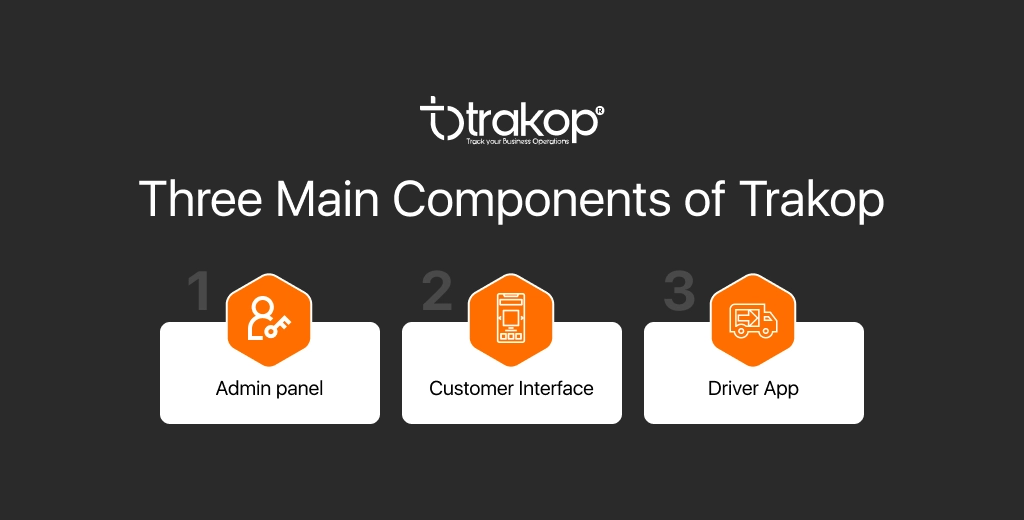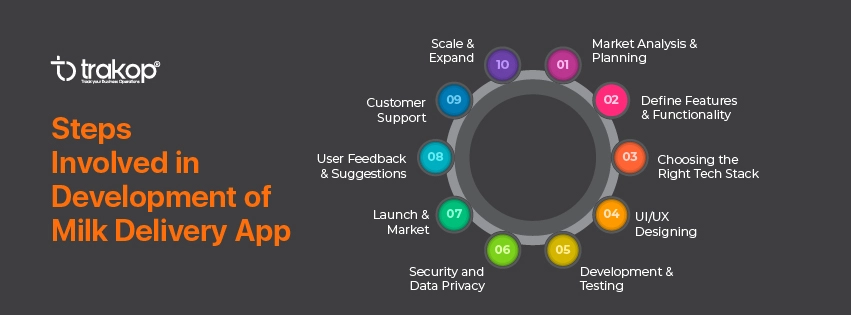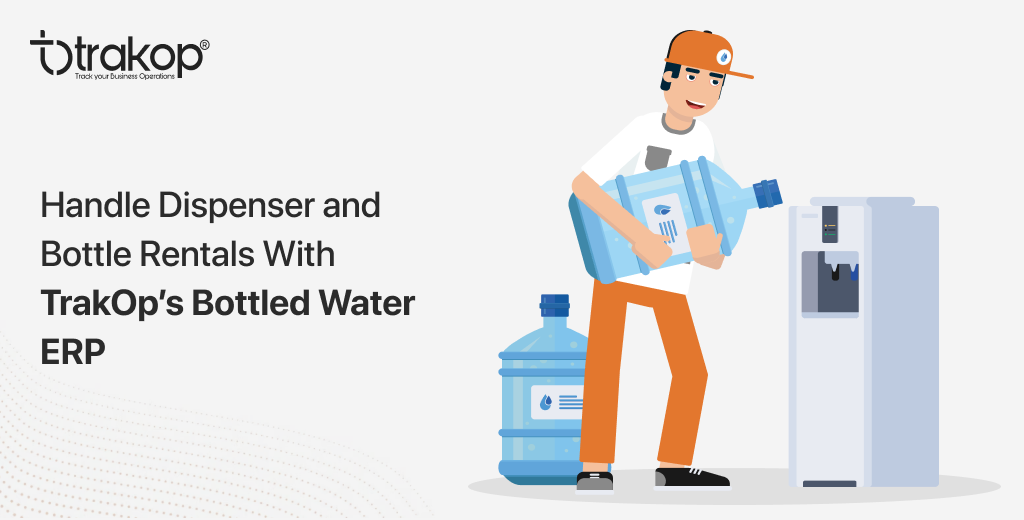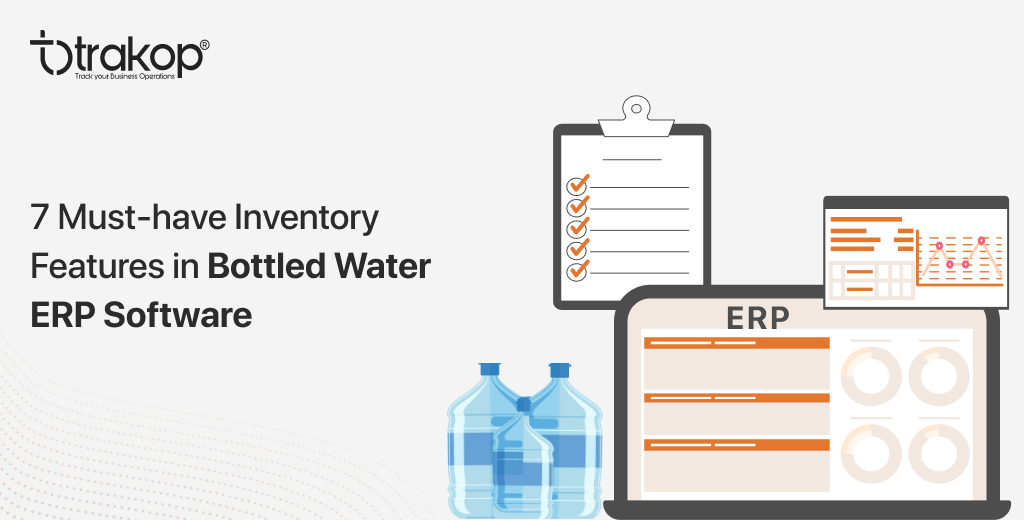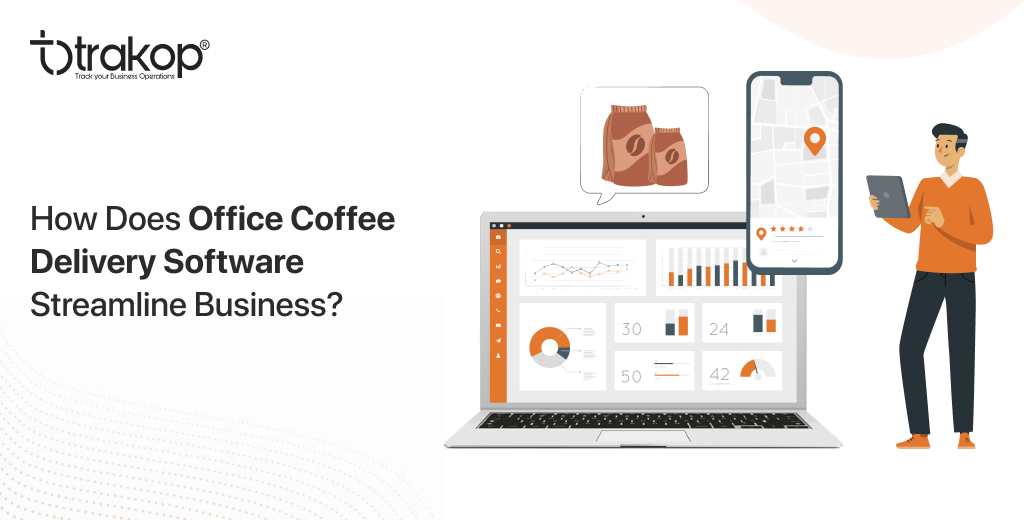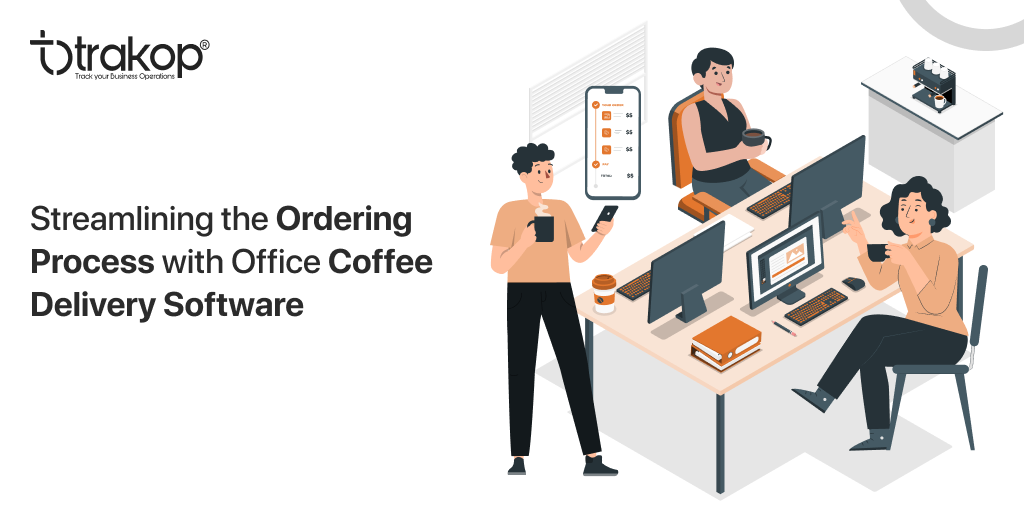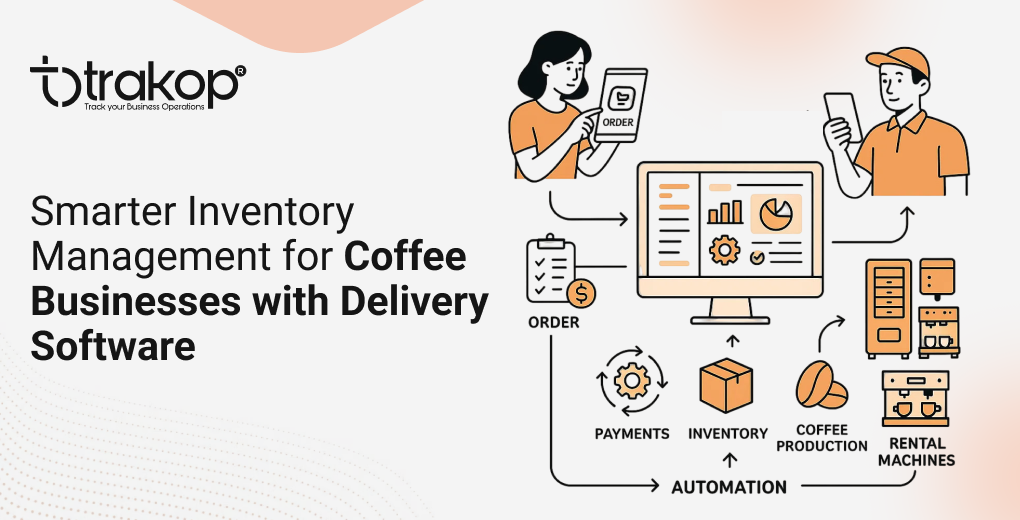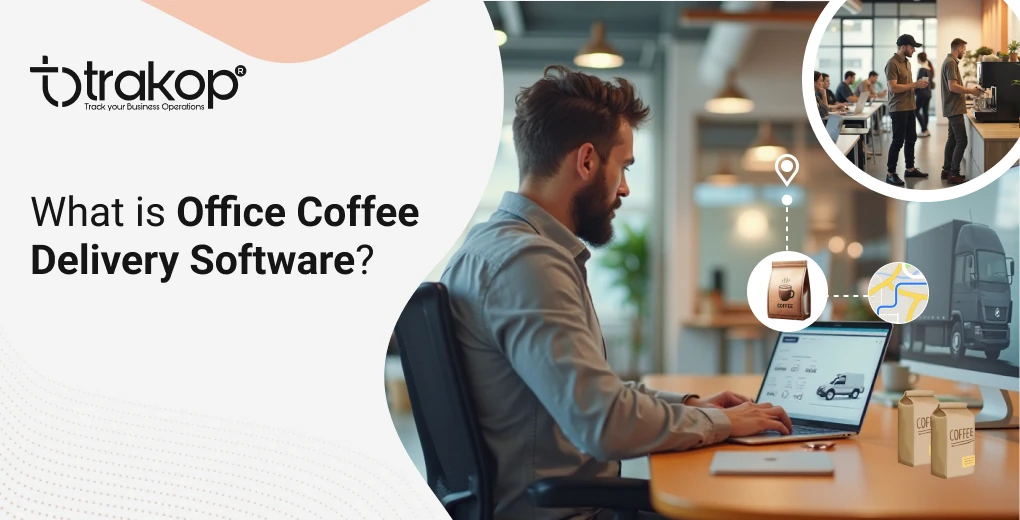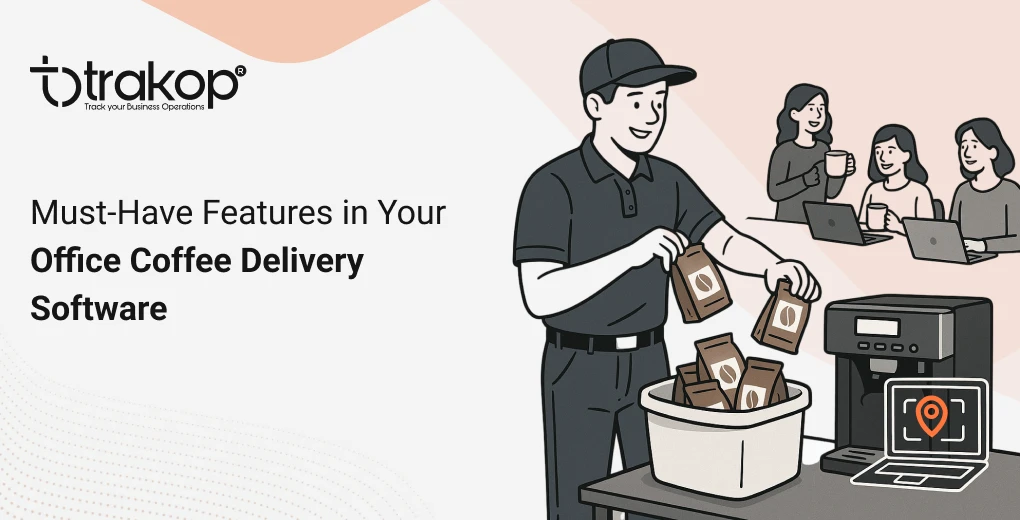Milk Delivery App Development: How to Guide
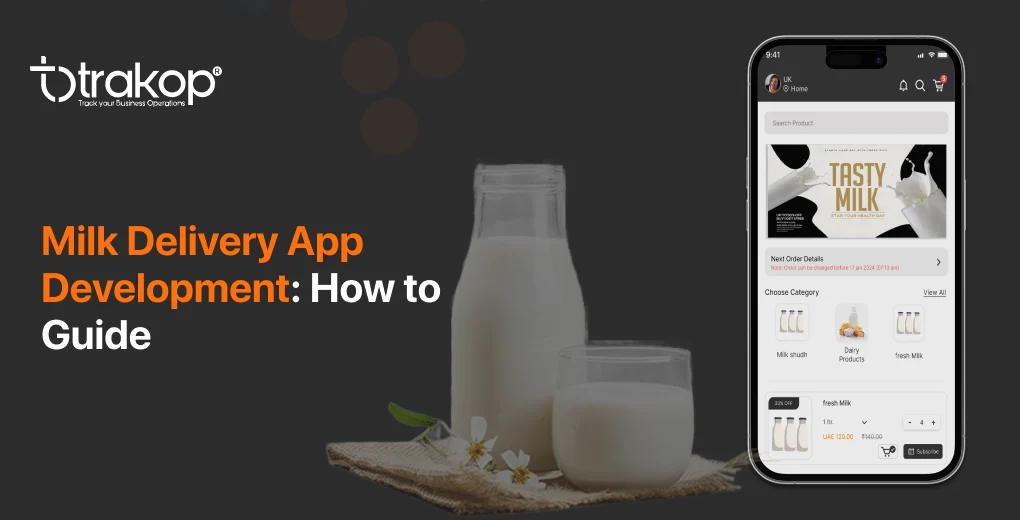
Convenience and efficiency are the top consumer preferences in the fast-paced world of today. Due to the increased demand for online services, traditional businesses are finding new ways to satisfy customer needs.
The dairy industry is changing to the digital age, and milk delivery apps are gaining popularity. This guide will discuss every step involved in milk delivery app development.
The blog article covers:
What is a milk delivery app?
A milk delivery app is a mobile application for customers that allows them to place and manage orders. The delivery app works jointly with the admin panel and the driver app. This mobile app aims to streamline ordering and order fulfillment on the customers’ doorsteps, providing a seamless customer experience. It is a link between the milk vendor and the customers, allowing customers to place orders without calling the vendor.
How do milk delivery apps work?
Delivery apps for milk simplify the ordering process and allow customers to order hassle-free.
Here is the breakdown of the workings of this delivery app for;
Customers
- Download and signup – Customers download the milk delivery app from the app store (iOS) or Google Store (Android). They will create an account with basic information. They can log in if they already have an account.
- Add product to the cart – Customers browse the app, select their preferred products, and choose the quantity. They can subscribe or place a one-time order. Add that product to their cart.
- Delivery schedule – They select a convenient delivery window. The milk vendors define these delivery windows from the backend.
- Delivery frequency – If the order is subscription-based, the customer chooses delivery frequency – daily, alternate, or custom-day deliveries.
- Number of deliveries – Customers select the number of deliveries they need.
- Secure payment – They select the payment method, depending on the payment option defined by the milk vendor. The app allows prepaid and postpaid payment models.
- Order Confirmation – The customers receive an order confirmation email or push notification. The notification and email include information, like the chosen product, quantity, delivery time slot, and total cost.
Milk vendors
- Order processing – Once the customers place orders, they are sent to the milk vendor via their web panel electronically.
- Inventory management – The vendor checks the stock to ensure that he has sufficient stock to fulfill the order.
- Delivery route optimization – The customer address is sequenced and optimized with other addresses.
- Order assigning – The delivery driver is automatically assigned to the order allotted to that route.
- Out for delivery – The driver picks up the order and delivers it to the delivery address based on the chosen delivery window.
Delivery drivers
- Order updated in the app – The confirmed orders are auto-updated in the driver app.
- Order dispatch – The orders are picked and sent out for delivery with other orders.
- E-proof of delivery – The driver obtains electronic proof of delivery. The drivers can click pictures or take digital signatures as proof of delivery.
- Collects cash – They collect and record cash amounts in the app. The cash amount is auto-updated in the admin panel. The payment is confirmed with OTP from the customer’s registered number.
- Mark deliveries – The delivery drivers can mark the orders as delivered, canceled, or rescheduled as per the situation.
- Order delivery – The order is delivered successfully to the customers.
Why should you invest in a milk delivery app?
There are several compelling reasons to invest in a white-labeled milk delivery app. It is a smart move for your doorstep milk distribution business. Here is a breakdown of key reasons to invest in the milk delivery app development:
Increases convenience
- It saves time and simplifies the ordering process.
- The system allows customers to place recurring subscription orders, removing the need to reorder.
- The customers can choose a delivery schedule at their convenience.
Improves business efficiency
- The system integrates route optimization software, that creates the shortest delivery route for multi-stop deliveries, saving time, and fuel costs.
- The app automates order processing, reducing manual work and errors.
- Track inventory to ensure you have sufficient stock to fulfill customer orders.
- Automating operations and integrating solutions, like route optimization software streamlines business and improves the overall operational efficiency.
Enhances customer engagement
- Customers can give feedback on products and services.
- The referral and earn feature encourages repeat sales and customer retention.
- You can provide personalized experiences to your customers through order history and feedback they give.
- Offering convenience, flexibility, and loyalty programs leads to a positive customer experience and fosters brand loyalty.
Competitive advantages
- The milk delivery app serves the increasing customer demands and saves time.
- Gives a competitive edge against businesses operated manually.
- The system offers marketing tools and improves brand visibility over the internet, increasing brand awareness and attracting potential customers.
Qualities of a successful milk delivery business
The success of the milk delivery business depends on various factors, like customer satisfaction, convenience, and efficient deliveries. In this section, we’ll explore the attributes of a successful business that you can compare to see if you are in the right direction.
Attributes of a successful milk delivery business
- Consistent morning milk delivery – A successful milk business ensures consistent deliveries of fresh milk every day. Milk is a staple and is needed every morning. The milk deliveries should be made before 7 am, fulfilling customer needs on time.
- Discounts and offers – The milk delivery business offers attractive deals and discount coupons that can improve customer engagement and retain customers. This fosters repeat orders and brings new customers.
- Secure payment options– A successful milk delivery business provides multiple and secure payment options to minimize cart abandonment rates, improving the order value and overall revenue.
- Subscription model – Milk is an everyday need. Offer a subscription model using subscription management software to enable consistent milk deliveries for the selected period. It removes the need for the customers to place orders every time they need milk.
- Hassle-free refunds – A seamless refund process improves customer experience and enhances customer retention rates. It improves customer loyalty, enabling a consistent stream of revenue.
Types of milk delivery app models
- Subscription model – It is the most popular model in milk delivery. Milk is a daily morning product, which is required every day, which makes it best suited for a subscription model. A subscription delivery model refers to recurring delivery services that make deliveries at a certain time.
- On-demand milk delivery – This app involves delivering milk on demand at a specified timeframe. For example, Getir is an on-demand platform that delivers in 10 minutes.
- Farm-to-door delivery model – It is a direct-to-consumer business model app that removes intermediaries and allows businesses to deliver fresh milk from the farm to their tables.
What are the features you should consider while developing a milk delivery app?
The milk delivery app offers various features that streamline and optimize milk deliveries. It automates milk deliveries to improve efficiency, productivity, and profitability.
The must-have features of milk delivery apps are:
Order management
- Place one-time and subscription orders.
- Edit and cancel one-time and subscription orders.
- Pause and resume milk subscriptions.
- Auto-generates order summary and invoice.
Product management
- Add as many products to the system. They are reflected on the customer app.
- Hide/ show products from the customer app, edit, and delete products.
- Add product pictures and descriptions.
- Manage product pricing.
- Product-wise day allocation.
- Product-wise cut-off time.
Stock management
- Generate stock reports for detailed information on available stock and required stocks.
- Create purchase lists.
Delivery planning
- Create delivery areas and delivery routes with geofencing.
- Define delivery schedules.
- Schedule-wise cut-off time.
- Create driver profiles and assign schedules and routes.
- Manual and auto-route optimization and sequence delivery addresses.
- Order auto-dispatch.
- GPS navigation for seamless deliveries.
Payment collection
- Auto-generate invoices and send them via email or WhatsApp.
- Multiple payment options offer flexibility.
- Pending payment and low wallet balance reminders.
- Supports prepaid, postpaid, and hybrid business payment models.
Delivery tracking
- Deliver tracking for vendors.
- Order tracking for customers.
- Orders status updates.
Field service app
- Daily task clarity.
- Collect and record payments.
- Order modifications in the run time.
- Create orders for new customers.
- Electronic proof of delivery.
- Record empty milk bottles.
- Mark deliveries – deliveries, canceled, or rescheduled.
Notifications
- Custom and automated notifications via email, SMS, and push.
- WhatsApp invoicing.
- Payment reminders.
- Delivery instruction notes.
Promotions and coupons
- Referrals and rewards.
- Cashback on recharge.
- Yearly membership plans.
- Discounted trails.
- Discounted coupons.
- Subscription discount coupons.
Future trends in the milk delivery industry
Dairy Market size is estimated at 620.00 billion USD in 2024, and is expected to reach 768.80 billion USD by 2029, growing at a CAGR of 4.40% during the forecast period (2024-2029).
The increasing demand for fresh milk, convenience, and shifting customer behavior has led to the development of technological solutions, like milk delivery management software. There are ongoing developments and advancements made to the technology to meet evolving customer requirements. From managing orders manually in a sheet to customer ordering from a digital platform, the technology has brought a great shift in the way milk businesses are managed.
Latest trends in the milk delivery industry:
Focus on sustainability
- Technology optimizes delivery routes, which results in reduced delivery distance, and fuel consumption. It minimizes the impact of carbon footprinting due to carbon dioxide emissions.
- Deliver milk in reusable containers, like glass bottles, rather than in plastic pouches. Track your empty bottle returns with integrated reverse logistics software.
- Use electric vehicles to make the deliveries. It reduces the impact on the environment due to carbon emissions.
Customization and personalization
- Allow customers to customize their subscriptions. They should be able to choose the product, delivery window, and the number of deliveries.
- Offer multiple secure and multiple payment gateways.
- Manage customer date to offer a personalized experience.
Technological advancements
- Integrate a unified software solution to automate, track, and manage your milk delivery business.
- Enable your customers to track their orders in real-time
- Use route optimization features to streamline deliveries for on-time deliveries.
Evolving customer preferences
- Allow customers to place and manage their orders.
- Enable customer to track their orders.
- Offer flexible and secured payment options.
- Allow them to give feedback and suggestions.
Increasing competition
- Expand your business. Implement up-selling and cross-selling techniques.
- You can offer dairy products, groceries, fresh produce, and milk.
How can you develop a milk delivery app?
Market analysis and planning
Do in-depth market research before starting an app development project. Know your target market, what they like, and who the competition is. Do milk delivery apps exist in your area? What special features can your app provide? Identifying gaps in the market is essential. Create a detailed business plan outlining your goals (like convenient milk delivery) and how you’ll make money (subscriptions or one-time purchases). Consider app development cost, marketing to get users, and ongoing maintenance for a clear financial picture.
Define features and functionality
Choose the main features your milk delivery app will offer based on your research. Typical features include three components:
- Business Dashboard
- Driver App
- Customer Interface
The business dashboard
- Order assign and schedule – The system auto-assigns orders to the drivers to whom that particular route has been assigned. The software auto-schedules orders based on vendor-defined schedules.
- GPS tracking – Vendors can track their delivery drivers in real-time to measure their performance and see delivery status.
- Payment reconciliation – Automate payment reconciliation to remove data discrepancies and customer disputes.
- Order process – Digitise the ordering process, mitigate the chances of human errors, and ensure order accuracy.
- Route optimization – Generate the shortest delivery route and sequence the deliveries to ensure that the order is delivered on time and the total turnaround time is reduced.
- Data and reports – The system auto-generates data and reports on customers, sales, and stocks that can help plan future sales and scale the business.
The driver app
- Delivery clarity – Give your drivers clarity on tasks and assigned orders and update order status with the smart delivery boy app.
- Contactless deliveries – Multiple payment gateway integrations are available for easy and secure contactless payments.
- E proof of delivery – A contactless customer signature and delivery proof photo for the order delivery status update.
- Real-time order update – Update or cancel orders via the delivery app, which is synced with the back office in real time.
The customer interface
- Notifications – Real-time updates on order status, payments, and delivery promote transparency.
- Track deliveries – Delivery agent updates, live tracking, and providing ETAs for hassle-free deliveries.
- Subscription management – Place, edit, or cancel their subscriptions from the white-labeled consumer app.
- Access orders digitally – Customers can access their order history any time they want for order reconciliation with the invoices.
Tech stack required for milk delivery app development
Making the right technology stack choices is essential for successful app development of delivery management software.
Consider these elements:
Platform – Will your app be available on Android, iOS, or both? Native development or cross-platform should be decided here.
Backend – Choose a reliable backend technology and a suitable database system.
Hosting – Cloud services like AWS, Google Cloud, or Azure are options for backend hosting. AWS is a popular and secure choice.
UI/UX Design
The user interface (UI) and user experience (UX) of the application influence the success of your milk delivery business. Design a user-friendly, intuitive interface with a visually appealing layout.
Focus on:
Easy navigation – Make sure users can easily browse products and place orders.
Visual appeal – Use eye-catching images, icons, and color palettes that keep with your brand.
Responsive design – Create a mobile application that can adapt to different screen sizes and orientations.
User feedback – Real users can help you test your design and collect suggestions for enhancements.
Development and testing
The front-end and back-end of the application are built into the development process. Developers will program the app functionalities and integrate APIs for GPS tracking, payment gateways, and other features.
To find and correct any bugs or glitches, thorough testing is necessary. Perform user acceptance testing (UAT), integration, and unit testing. To get user feedback, conduct beta testing with a small group.
Security and data privacy
Security is crucial to protecting customer and payment data. Encryption protocols secure data transmission. Consider industry standards for data storage.
Obtain user consent and handle data sensibly to adhere to data protection laws. Update your app frequently to fix security flaws.
Launch and market
After testing and development, the app goes live. Confirm that it complies with the App Store and Google Play Store requirements.
Create an all-encompassing marketing plan that includes influencer marketing, email campaigns, social media marketing, and SEO optimization. Increase your audience by utilizing regional alliances with dairy suppliers.
User feedback and suggestions
It is essential to think about gathering user feedback and enhancing your app over time after the application is live. Conduct surveys and collect data on user behavior to find areas that need improvement. Regularly update the app to add new features and fix any issues.
Customer support
Offer your customers satisfying customer support and respond to their feedback and issues. Provide excellent customer service to address user concerns and inquiries quickly.
Scale and expand
Scale your milk delivery business with technology to additional regions or cities. To scale, you need development and logistical assistance. To ensure a seamless user experience, monitor the app’s performance and scalability.
A user-centric strategy, careful planning, and continuous improvement are necessary to create dairy management software. You can make successful software with a milk delivery app development service to satisfy modern consumers’ needs. This detailed guide can help you provide efficiency and convenience.
Hope You Enjoyed the Read!

He loves to explore. His passion for helping delivery industries in all aspects flows through in the vision he has. In addition to providing smart solution to make delivery process flawless, Ravi also likes to write sometimes to make it easier for people from business industry looking for digital solutions.
